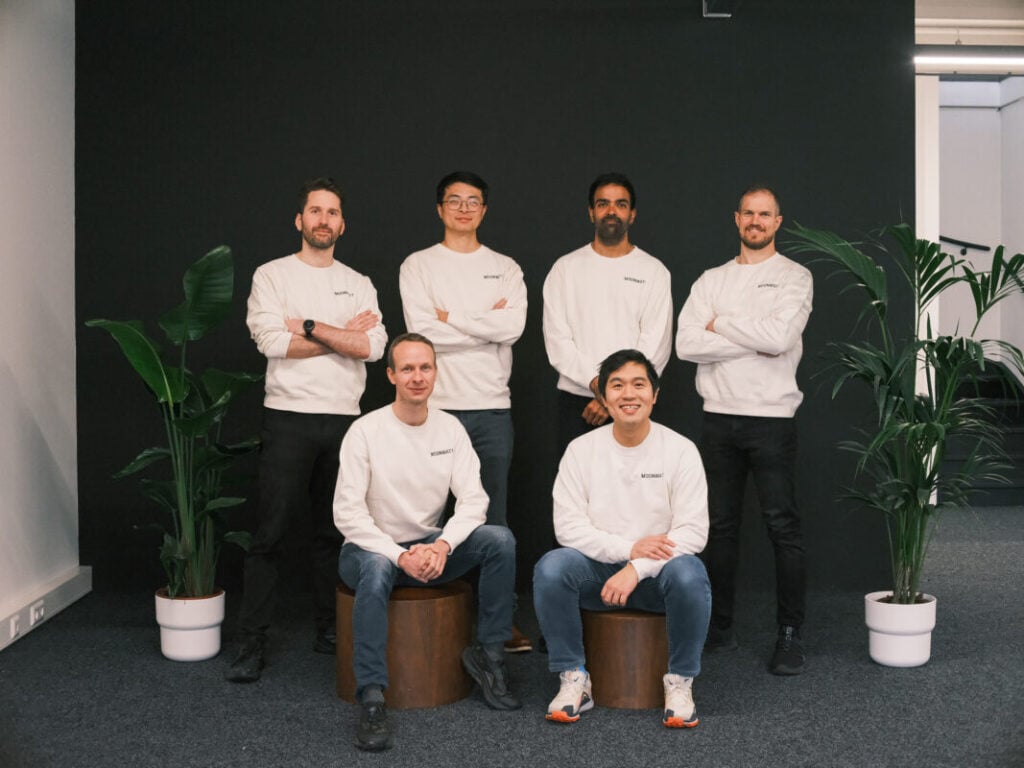
Netherlands-based startup Moonwatt plans to commercialise an energy storage solution for hybridisation with solar using two big technological deviations from today’s industry standard – we hear more from the firm’s CEO and COO.
CEO Zukui Hu, CCO Valentin Rota and CTO Guillaume Mancini met nine years ago while working at Tesla. All three then moved to Norwegian lithium-ion battery gigafactory startup Freyr together in October 2021 – a firm which ultimately failed in its European battery plans and has since pivoted to become a US solar company – before founding Moonwatt last year.
Enjoy 12 months of exclusive analysis
- Regular insight and analysis of the industry’s biggest developments
- In-depth interviews with the industry’s leading figures
- Annual digital subscription to the PV Tech Power journal
- Discounts on Solar Media’s portfolio of events, in-person and virtual
Or continue reading this article for free
That makes Moonwatt’s alternative approach to its energy storage system (ESS) hardware and software solution designed for hybridisation with solar all the more interesting.
Instead of the 20-foot container which dominates grid-scale ESS industry today, it will deploy a ‘distributed’, smaller 80kWh (roughly) unit distributed across the solar site. And instead of lithium-ion it plans to use sodium-ion cells. Hu and Rota discussed both in detail with us in this interview.
‘Balance of plant’ is where the savings can be made
Battery cells are getting cheaper and cheaper, but a more untapped cost saving on energy storage projects co-located with solar is reducing the balance of plant (BOP) costs, Rota said. The challenge to reduce cost is to further integrate solar into storage, he claimed, which the ‘cookie-cutter’ grid-scale products struggle to do.
“Our offering first and foremost is the battery enclosure box, which is a two to three cubic meters box and very distributed across the project site. And the other thing it includes is the string inverter, and the hybrid string inverter. So it’s an inverter to which we connect both the solar panels on the one side and the battery on the other. And this string inverter looks like most solar string inverters, it’s about 100 kilograms that you attach on the mounting structure,” Rota explained.
The firm is designing its solution for a 4-hour duration configuration, the sweet spot for solar hybridisation, he added.
But, how does this approach result in better project economics than using a big 5MWh ESS unit with central inverters?
“We reduce the balance of plant costs, by getting rid of some cable trenches, transformers, switch gear and the need to install them. We put storage but we use as much of the solar’s existing infrastructure as possible. The DC-coupling improves the efficiency of the electricity from the PV to the grid,” he explained.
“That isn’t a new topology, but what’s changing is the PV panels are becoming so cheap that the main costs for developers are now the connection and balance of system/plant. The DC to AC ratios of plants are increasing and having conventional PV plus BESS loses electricity in the inverter’s conversion step.”
The firm’s solution also still enables the BESS to charge and discharge on the grid when it isn’t needed for shifting solar production, Rota said.
“We believe capex for our projects will be around 20% cheaper than conventional solutions because of how we are optimised around the design and installation of our technology,” Hu added.
Hu also said that its ESS solution could be added to existing solar PV plants without affecting permitting or land constraints because it is small enough to be installed within the site’s small footprint.
The economics of combining solar and storage are also becoming stronger, the pair added. Energy-Storage.news has heard this from other sources in Europe, including most recently IPP Econergy.
Sodium-ion
Repeating what others have suggested, Rota said that there is currently an imbalance of supply and demand in the lithium-ion space with some companies ‘losing money’. While not seeing lithium-ion, lithium iron phosphate (LFP) battery prices ‘going up like crazy’ again, he does foresee a rebalancing down the line.
“With sodium, we lived the transition from NMC to LFP. People thought that would never happen, but it did, because it was cheaper and that compensated all its disadvantages,” Rota said.
“Guillaume, Zukui and I spent a lot of time going to China in the last few years seeing the roadmaps for LFP and sodium-ion. And what we saw on sodium-ion and its manufacturing and supply chain was much more advanced than what we thought. LFP’s manufacturing is several orders of magnitude higher, with sodium-ion at only 10 or 20GWh, but its prices are not that far off. “
LFP has a theoretical floor of US$25 per kWh while sodium-ion’s is US$5 per kWh, Rota added.
The lower density of sodium-ion is also not an issue for Moonwatt’s solution because of its distributed approach, and the firm wants to get a head start on developing the technology for ESS.
Roadmap
Moonwatt is working on different prototype iterations and its first pilot project will be deployed within a year, with its first commercial, large-scale volumes taking place in 2027 onwards. It is targeting a ‘few dozen megawatt-hours’ in 2026, a few hundred in 2027 and gigawatt-hours in 2028 onwards.
The firm recently raised €8 million in a fundraising round from venture capital firms daphni and LEA Partners as lead investors, with Founders Future, AFI Ventures (by Ventech) and Kima Ventures participating alongside strategic business angels and customers.

